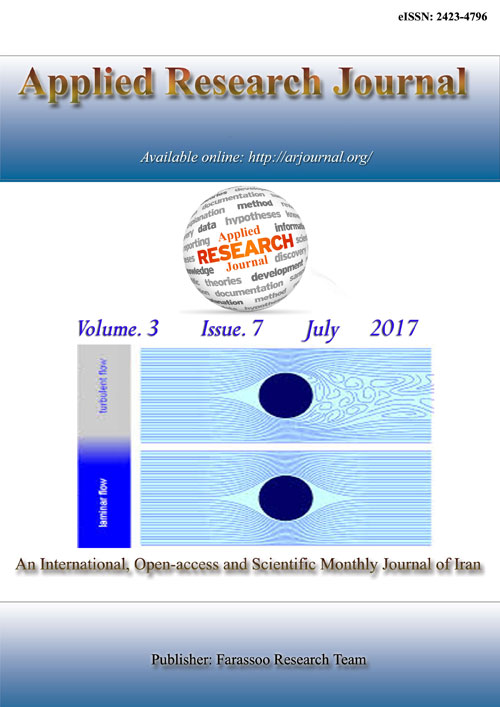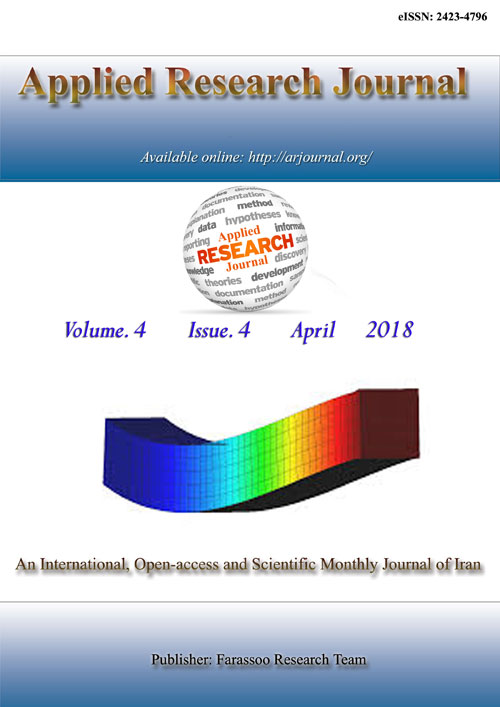فهرست مطالب

Applied Research Journal
Volume:3 Issue: 7, Jul 2017
- تاریخ انتشار: 1396/06/30
- تعداد عناوین: 3
-
Pages 205-215Zeolite membranes have uniform and molecular-sized pores, and they separate molecules based on differences in the molecules adsorption and diffusion properties. Strong electrostatic interaction between ionic sites and water molecules (due to its highly polar nature) makes the zeolite Hydroxysodalite (HS) membrane very hydrophilic. Zeolite HS membranes are thus well suited for separating liquid-phase mixtures by pervaporation. In this study, experiments were conducted with various Ethanolwater mixtures (120 wt. %) at 25 C . Total flux for Ethanolwater mixtures was found to vary from 0.319 to 0.226 kg/m2.h with increasing Ethanol concentration from 1 to 20 wt.%. Ionic sites of the HS zeolite matrix play a very important role in water transport through the membrane. These sites act both as water sorption and transport sites. Surface diffusion of water occurs in an activated fashion through these sites. The precise nanoporous structure of the zeolite cage helps in a partial molecular sieving of the large solvent molecules leading to high separation factors. A comparison between experimental flux and calculated flux using Stephan Maxwell (S.M.) correlation was made and a linear trend was found to exist for water flux through the membrane with Ethanol concentration.Keywords: Nano pores, Pervaporation, separation, Zeolite, HS membrane
-
Pages 216-230This study deals with the problem of analytical investigation of thermal radiation effects of laminar flow of fluid and heat transfer in a channel with two porous bounding wall of different permeability. Perturbation technique is applied for the solution of non-linear differential equation. Numerical simulation is used to analyze the problem and MATLAB software is used. The main focus of this paper is to investigate the effect of Reynolds number Re, Prandtl number Pr, Permeability parameter K and parameter & on non-Newtonian fluid velocity and temperature coefficient. The effect of large as well as small Reynolds no is also seen in graphically.Keywords: Reynolds number Re, Prandtl number Pr, Permeability Parameter K, Porous wall, Channel flow
-
Pages 231-242Annually, the large amount of waste is generated from ceramic industry. A win-win situation can be obtained with reusing these wastes in concrete. Because on the one hand, the waste problem in ceramic industry is resolved, and on the other hand leading to a sustainable construction industry. This research studies the properties of pozzolanic concrete containing white and red paste ceramic wastes integration with nano-SiO2 and metakaolin as a pozzolan. This research was done in two different phases: in the first phase, possibility of replacing 5 to 15 percent of waste sanitary ceramic and waste floor ceramic tile was studied. In the second phase of the research, the simultaneous influence of using metakaolin and nano-SiO2 incorporating ceramic powder was studied. Results show that application of ceramic wastes as a binder has slight effect in compressive strength of concrete, On the other hand, this replacement improve durability performance. In addition, using nano-SiO2 and metakaolin with ceramic powder simultaneously leads to improved durability and mechanical properties. Finally, it can be said that using the wastes of ceramic, leads to decline in cement consumption, recycling of ceramic wastes, improve protecting the environment and construction economy. Keywords: Ceramic Waste, NanoSiO2, Metakaolin, Concrete, Sustainable development.Keywords: Concrete, Ceramic wastes, Metakaolin, NanoSiO2, Mechanical properties


